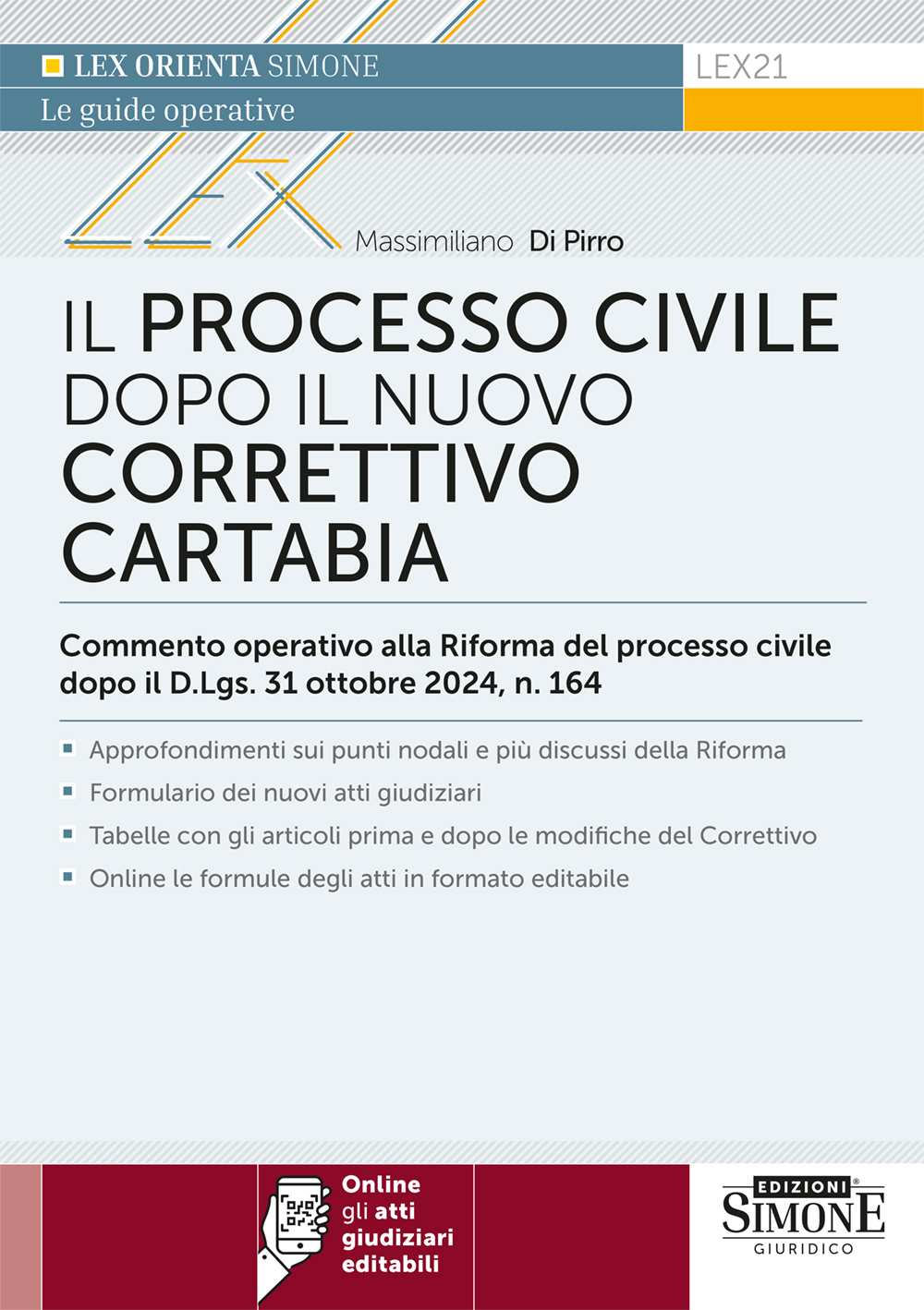Libreria Giuridica Sauzano
The Civil Process after the New Cartabia Corrective – LEX21
The Civil Process after the New Cartabia Corrective – LEX21
SKU:
Couldn't load pickup availability
Just over a year after the entry into force of Legislative Decree 149/2022 , the civil procedure regulations have been modified again: the new legislative decree correcting the Cartabia Reform ( Legislative Decree 31 October 2024, n. 164 ) after a long process has finally been published in the Official Journal 11 November 2024, n. 264.
The Corrective Law introduces numerous amendments to the Civil Code, the Code of Civil Procedure and the implementing provisions, as well as to some special laws.
This text, which comes out the day after the final approval of the reform decree, examines, with a practical-operational approach, all the innovations introduced by the new Corrective, offering a timely interpretation of the regulatory interventions. A specific analysis is also dedicated to the reform prospects on mediation and assisted negotiation.
Always with a view to providing a useful operational tool for the professional, this edition is accompanied by an annotated form with the main procedural documents affected by the new reform, as well as a table with a comparison of the pre and post Corrective structure .
The aim is twofold: on the one hand, to make the reading of some of the rules of the Cartabia reform clearer and some procedural issues more fluid, especially for the new family procedure; on the other, to complete the digitalization of the civil process, eliminating all "manual" obligations for the parties.
Despite expectations, the Corrective Law does not substantially intervene in the introductory phase of the civil process: preliminary checks on the regularity of the adversarial process remain mandatory, to be carried out within 15 days of the defendant's appearance. It is in this phase that the most important critical issues of the new procedure are concentrated, since it distances the parties from the judge at a crucial moment of the process, in which the preliminary issues are addressed and defined.
The Constitutional Court itself 96/2024 has recognized the critical issues of the new procedure, which risks compressing the adversarial principle, structuring the preliminary checks phase in such a way that the judge, before the hearing pursuant to art. 183 of the Code of Civil Procedure and the supplementary briefs pursuant to art. 171ter of the Code of Civil Procedure, can decide the issues by decree without calling the parties to discuss them. However, the ruling of the Constitutional Court has provided a constitutionally oriented interpretation of the provisions of the Cartabia reform, leveraging the powers of the judge in charge of the process (art. 175 of the Code of Civil Procedure and art. 127 of the Code of Civil Procedure), thanks to which he can always set the hearings he deems useful and, therefore, can make up for the lack of adversarial procedure, prior to the issuance of the decree, by setting the appropriate hearings so that the parties can intervene on the issues covered by the decree.
However, the rules for the transition from the ordinary procedure to the simplified procedure pursuant to articles 281decies et seq. of the Code of Civil Procedure change: in fact, the possibility is foreseen for the transition to the simplified procedure to be arranged already in the preliminary checks phase, with the judge setting - by decree - the hearing referred to in paragraph 1 of article 281decies of the Code of Civil Procedure and the peremptory deadline within which the parties can integrate the introductory documents by filing briefs and documents.
This step will no longer be decided with a non-appealable order but with a decree, so that, once the hearing has been reached, after cross-examination with the parties, the judge could change his mind and return to the ordinary procedure! In short, the legislator, rather than facilitating the path towards the decision on the merits, is concerned with establishing on which track the wagon of the process should travel.
Another change consists in the elimination, from art. 380bis cpc, of the obligation to confer a new power of attorney to present the appeal to the Supreme Court in the event of a proposal for a negative definition by the reporting judge. This innovation simplifies the procedures, accepting the requests made by the legal profession, which had harshly criticized the previous version of the rule.
The digitalisation of the process is then further strengthened, simplifying the obligations of the parties and the registries and eliminating obligations that are now anachronistic and useless.
Furthermore, the rules for notifications via PEC are improved and simplified and the use of this tool is expanded.
Furthermore, debt collection is facilitated through the instrument of the injunction, and the simplified cognition procedure is extended to all cases within the jurisdiction of the single-judge court, even if they are not readily resolvable.
Some rules have been amended to correct errors in their wording: this is the case, for example, of art. 319 of the Code of Civil Procedure, which clarifies that the case is entered into the register by filing the appeal or the report containing the oral request, which must then be notified to the defendant together with the decree setting the hearing, and of art. 343 and 347 of the Code of Civil Procedure, since it was not clear what the deadline for the respondent to appear was and whether or not this coincided with the deadline for filing the incidental appeal.
However, these and other innovations of the Corrective, often minor and of little practical impact, intervene exclusively on the procedural rules, in the illusion that by modifying the mechanism the system can be improved.
For over twenty years, "zero-cost" measures have promised to make the system more efficient, but the mere fact that the legislator must once again resort to yet another reform measure is clear proof that what has been done so far has served little purpose.
Not to mention the alternative dispute resolution procedures (the so-called ADR, alternative dispute resolution ): formally, the right of action is guaranteed to be exercised in the ordinary process, but in numerous disputes the party is obliged to close the dispute outside the process (in cases of mandatory mediation and assisted negotiation), transforming the civil process into a tool for resolving disputes, which the parties often accept more out of necessity than out of deep conviction.
The same accelerating logic animates the simplified cognition procedure, inserted in the second book of the code of civil procedure, a clear sign of the debacle of the process: the truth is no longer sought but plausibility is satisfied.
The material truth (the facts as they happened) is replaced by the procedural truth, that is, by an approximate truth whose purpose is the rapid resolution of conflicts and a (significant) saving of resources for the parties and the State, in deferential homage to the diktats of the PNRR.
This text, which comes out in the aftermath of the final approval of the reform decree, examines, with a practical-operational approach , all the innovations to the civil procedure introduced by the new Cartabia Corrective, offering a timely interpretation of the regulatory interventions.
Always with a view to providing an operational tool, useful for the professional, this edition of the Civil Process after the new Cartabia Corrective is accompanied by a commented form with the main procedural acts on which the new legislative decree has had an impact, as well as a table with the pre and post Corrective structure compared .
In the reserved online area, accessible via the QRCode, at the bottom of the volume, the form with the judicial documents in editable format.
Share


